The best varieties of bush pumpkins
Unlike climbing bush pumpkin, it does not spread long shoots and does not spread along the ground. Many people grow it to save space. Some of the grooming steps required by climbing species are omitted to make growing easier. The varieties of such pumpkin are characterized by the fact that you do not need to wait long for its harvest. The fruits are mostly small.
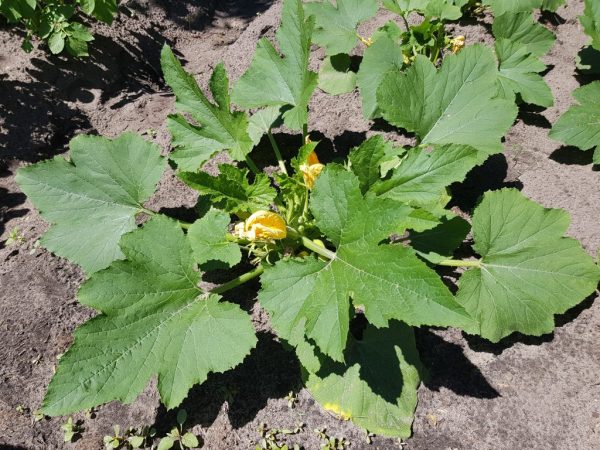
The best varieties of bush pumpkins
Variety selection
When cultivating a pumpkin, you need to take into account the conditions of a particular region. Some bush species can produce high yields even in difficult and changeable climates.
For Siberia
If you do not take a responsible approach to the choice of a variety, you can remain dissatisfied with the result of cultivation. The region is characterized by harsh conditions. Such popular species can ripen here:
- The freckle is spherical, slightly flattened. Weight up to 3 kg. Ripens early. The skin color is greenish with yellow dots. The pulp is juicy, sweetish, has a fruity flavor;
- Adagio - fruits are round, strongly flattened, with a depression near the stalk. Average weight - 3 kg. Ripening period is medium early. The pulp tastes good. The product is used for the production of dietary and baby food.
For the Urals
The region is characterized by long periods of frost. Most varieties are suitable for growing, except for the Amazon and Honey Beauty. Among them, there are types:
- Dachnaya is a cold-resistant variety, characterized by an early ripening period. Fruit weight - up to 4 kg. The peel is green with yellow stripes. The pulp is yellow, tasty. Has a pleasant scent;
- Shrub golden - early ripening species. The fruits are round, flattened. Weight - up to 5 kg. The surface is segmented. The rind is golden. The pulp is yellow, crispy, unsweetened.
For central Russia
Varieties of bush pumpkins for the region must be zoned, otherwise the fruits will not have time to ripen. For cultivation in the middle zone of the country, including the Moscow region, the following types are suitable:
- Muscat - the name unites species with similar characteristics. Their flesh is sweet. It is possible to grow a culture only by seedling, because it takes a long time to ripen;
- Aport - belongs to the most delicious varieties. Fruits are round in shape, slightly flattened at the top and bottom. The surface is almost smooth. It has an average ripening period. Weight - up to 7 kg. The pulp is juicy, crispy, sweet.
Review of the best varieties
Bush pumpkin fell in love with gardeners for its useful composition and excellent taste. Among the many species, some have received special recognition.
Smile
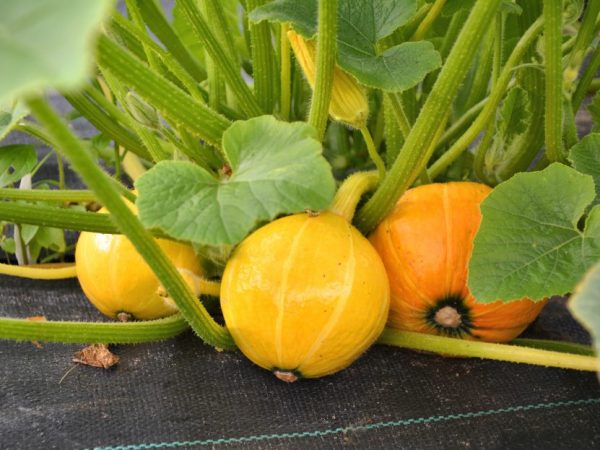
Fruits can be kept fresh for a long time
The variety was bred in Russia about 15 years ago. Perfectly adapted to difficult climatic conditions. It takes up to 3 months from mass germination to harvesting.
The plant is small. Forms 6 meter shoots. The leaves are large, green, patterned. The flowers are yellow or orange.They smell good.
The fruits are distinguished by the following qualities:
- spherical shape, slightly flattened;
- weight - 1 kg;
- orange peel, of medium thickness, firm, not segmented, striped;
- the pulp is orange, dense, with a melon smell;
- the taste is great.
There are up to 15 fruits on the bush. Female flowers form lateral lashes. The seed chamber is small. Seeds are oblong, white, smooth.
The Smile variety is valued for its transportability and frost resistance. It is grown in the Urals and Siberia. Productivity - 3 kg per 1 sq. m. Takes one of the leading places in dietary characteristics and vitamin content. Ripe pumpkin retains its presentation until the winter period.
Acorn
The second name is Acorn. Recently withdrawn. One of the earliest types of bush pumpkins. Harvesting is possible 80 days after the mass germination. There are also climbing varieties of Acorna.
The fruits are distinguished by the following characteristics:
- acorn-shaped - hence the second name;
- light weight - 600-700 g;
- thick skin with grooves;
- peel color from dark green to orange-spotted;
- dense, orange-yellow pulp;
- sweet taste.
Bush pumpkin of this variety is used for making desserts. Due to its special structure, it is easy to stuff it. Has good keeping quality. The peel does not need to be removed - it is edible. The seeds are delicious. Hard pumpkin species are often grown for them.
Lel
Obtained as a result of crossing Almond 35 and Nakhodka species. Belonged to ultra-early ripening - the fruits ripen 90-100 days after germination. Yield indicators - 25-40 t / ha. Marketability - 93%.
Fruits of the variety, according to the description:
- medium flattened;
- the peel is mostly smooth, has ribs near the stalk;
- the color in unripe form is dark green, then it becomes yellow-orange;
- average weight - 3.2 kg;
- orange pulp, medium density, juicy;
- tasting score - 4.2 points.
The Lel variety is immune to powdery mildew and anthracnose. Peronospora resistance is average. The application is mainly technical. Suitable for green conveyor. Pumpkin dishes are not cooked.
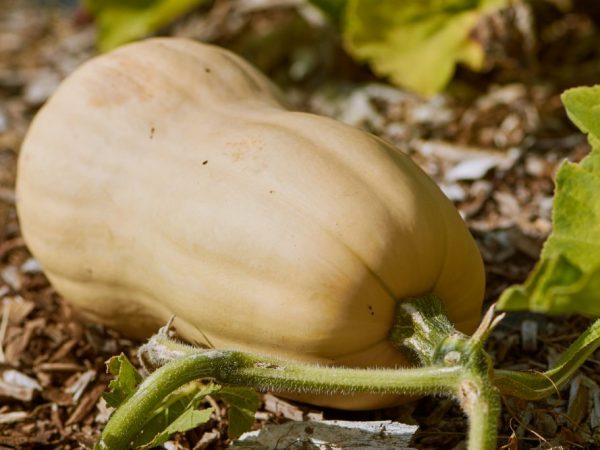
Lel variety is not suitable for human consumption
Creamy seeds. The output is 0.4-0.6 t / ha. They are used to obtain pumpkin seed oil, because the seeds contain up to 50% fat. Various medicines are made on its basis.
Amazon
The bush is compact. Forms up to 3 ovaries. The length of the main whip is 1 m. The leaves are dark green, small. The variety is early ripening - the harvest is harvested 80-85 days after germination.
The fruits are distinguished by the following qualities:
- rounded-flattened in shape;
- weigh on average 1 kg;
- the peel is dark orange, striped;
- the pulp is orange, sweet, crunchy.
Seeds are small, white-gray, rough. Juices, desserts, mashed potatoes are prepared from the fruits. Pumpkin dishes are one of the components of children's and dietary nutrition. The seed chamber is large. There are a lot of seeds. The fruits retain their presentation for about 4 months. Productivity - 36-68 t / ha.
Gribovskaya 189
The variety was bred by Russian breeders. It is especially popular in Siberia and the Urals. Early ripening - about 86-98 days pass from germination to harvest. Gribovskaya bush is valued for its high yield of fruits - up to 39.8 t / ha. It is resistant to rot, weakly affected by powdery mildew and bacteriosis.
The plant is powerful. Each bush has two fruits, which are characterized by the following description:
- the shape is oblong, tapering towards the base;
- weight - up to 5 kg;
- the surface is smooth or slightly ribbed;
- the peel is thin, strong, at first dark green, then orange with green stripes;
- the flesh is thick, firm, orange, sweet, pleasant to the taste.
The seed nest is large. The commercial qualities are high. Various dishes are prepared from Gribovskaya pumpkin, it is canned.
Honey beauty
A variety of butternut squash. Imported from China. Early ripening - about 3 months. Productivity - up to 50 t / ha. Has a relative resistance to powdery mildew.
The distinctive characteristics of the fruit are as follows:
- spherical shape;
- orange, often with green dots, with prominent ribs;
- weight - 6 kg;
- thin and strong peel;
- orange, crispy, aromatic and tasty pulp.
Ripe pumpkin must be stored. Porridge, desserts, juices are made from it. Transfers the grade of transportation over long distances.
Therapeutic
This pumpkin is the result of the work of Kuban scientists. The ripening period is early - up to 105 days. Productivity - 3.7-4.2 kg / m². Used for dining purposes.
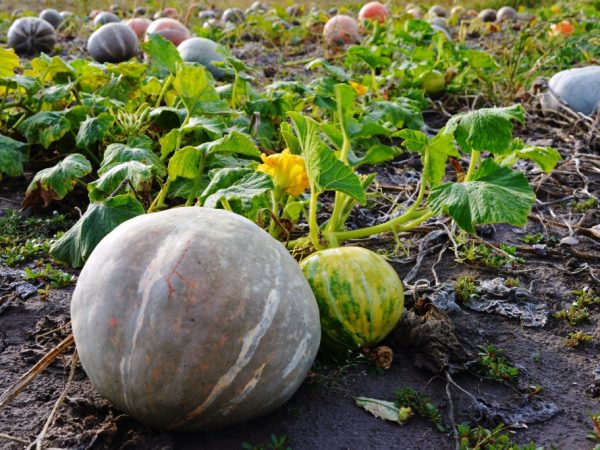
Pumpkin is prized for its good taste
The growth vigor of the bush is average. The whips are short. The sheet plates are 5-sided, solid.
Fruit:
- rounded-spit;
- gray;
- divided into small segments;
- weigh 3-5 kg;
- with a thin skin;
- with orange, medium thickness, crispy flesh;
- delicious.
The seed chamber is medium. Seeds are oval, white, smooth. Weight of 100 pieces - 27 g.
The Healing variety is affected by powdery mildew, gray and white rot, anthracnose. Pumpkin tolerates cold well. Withstands transportation and can maintain marketable qualities for a long time.
Bush orange
The pumpkin was obtained as a result of the work of the Kuban breeders. It is characterized by an average ripening period of 100 days.
Orange bush pumpkin is characterized by the following fruits:
- spherical;
- slightly ribbed;
- with orange and thin skin;
- weighing up to 4.5 kg;
- with orange, sugary, juicy, crispy and sweet flesh.
The application is universal. Pumpkin is suitable for salads, desserts, preservation, baking and winter storage.
Pearl
Grown pumpkin in the open field in central Russia. The bush has 6 shoots. One ovary is formed on each. Ripening period is about 100 days. From 1 hectare, 50 tons of fruits are harvested, which differ in the following characteristics:
- cylindrical shape;
- length up to 0.5 m;
- weighing up to 7 kg;
- orange peel with a bluish bloom;
- dark orange, dense, crispy and juicy pulp;
- sweet taste.
The seeds are small. The pumpkin can be stored for a long time, but due to its thin peel, damage may occur during transportation.
One hundred pound
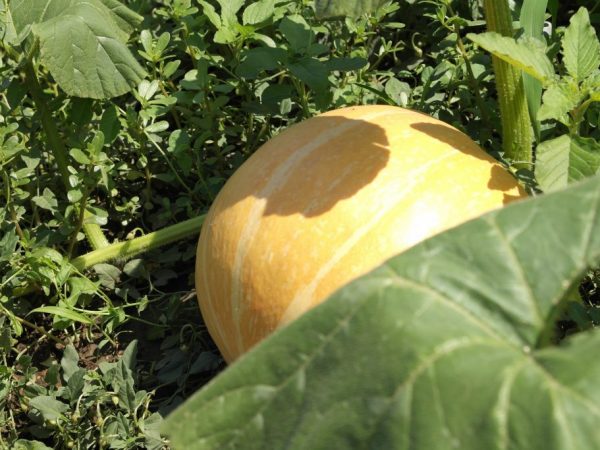
Fruit weight can reach 20 kg
Medium late - ripening occurs 130 days after germination. Productivity - 6.3 kg / m². It has immunity to bacteriosis, powdery mildew, rot.
Fruit:
- spherical;
- weakly segmented;
- large - weight 10 kg, sometimes 20 kg - subject to growing conditions;
- with a thin, yellow-orange peel;
- flesh with a loose structure, creamy yellow, not very sweet, slightly aromatic.
The species is characterized by a forage purpose. In demand in agriculture.
Features of growing in the open field
In order for the culture to please with high yields, it is necessary to follow the rules of agricultural technology.
Landing
The process involves several stages.
Site preparation
The pumpkin loves well-lit areas. The best "predecessors" for her are legumes, potatoes, onions and cabbage. The site is being prepared in the fall. To do this, under a deep digging of the earth for 1 m², the following substances are introduced:
- compost - 5 kg;
- potassium chloride - 15 g;
- superphosphate - 30 g.
With increased acidity of the soil, wood ash or lime is also added. In the spring, the earth is dug up again, but already shallow. Fertilize it by adding 20 g of ammonium nitrate per 1 m².
Seed preparation
For planting, seed that is less than 3 years old is suitable. First, large and full-bodied seeds are selected. Then they are poured with water heated to 50 ° C. Leave for several hours. Then wrapped in a damp cloth. The hatched seeds are placed in the refrigerator, in the vegetable compartment.
Sowing in open ground
This planting method is used in regions with a warm climate. When the ground at a depth of 10 cm warms up to 12 ° C, holes are made. Watering. Place 2-3 seeds in each well. The planting scheme is 0.7 × 0.7 m. After germination, one most strengthened sprout is left.
Growing seedlings
Vessels with a volume of 0.3 liters are filled with earth, which is mixed half with humus.Seeds are germinated 20-22 days before the expected date of planting. They are deepened by 5 cm, directing the "nose" down. Leave in a warm room - 22-25 ° C. After the sprouts appear, the temperature is gradually reduced.
Water the plants regularly and in moderation. They are fed twice using a complex fertilizer. 1-2 weeks before planting, the crops are hardened. They are planted in open ground in the phase of 3-4 leaves.
Care
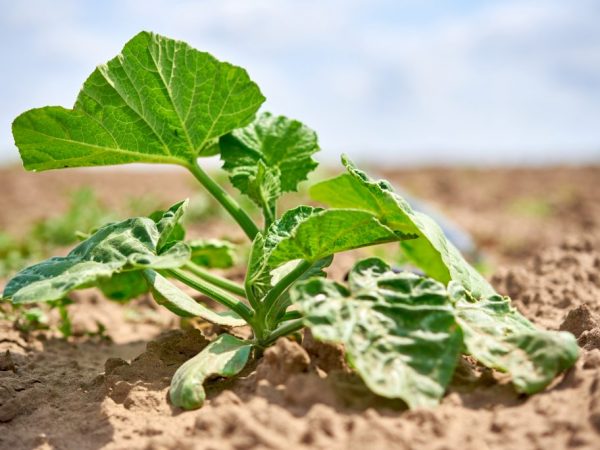
The plant needs regular watering
Bushy pumpkins need to create favorable conditions.
Watering
The culture actively evaporates moisture through the leaves. Watering is carried out regularly. Plants especially need an abundant amount of moisture during such periods:
- before flowering;
- during the formation of fruits.
The water is taken in a settled and warm water - 20 ° C. Watering is stopped a month before harvesting. Plant care involves loosening the soil after each wetting.
Top dressing
If the soil has been fertilized in the fall, then additional nutrients are not needed. When she is depleted, the following dressings are carried out:
- 10 days after planting, take 1 liter of manure in a bucket of water. You can also take 10 g of nitrophoska per 10 liters of liquid;
- during fruiting, use the same formulations.
You can fertilize plants 3-4 times. Instead of manure, chicken manure and green fertilizer are used. Organic dressings alternate with mineral ones.
Artificial pollination
If the weather is bad and there are no pollinating insects, you need to transfer the pollen yourself. To do this, use a soft brush. You can also lean the male flower against the female stigma.
Advantages and disadvantages
The advantages of bush crop varieties include:
- compactness - this property allows you to grow a plant in small areas of open ground;
- the structure of the bush - thanks to it, moisture in the soil remains longer, which has a positive effect on productivity;
- tolerance to low temperatures;
- ease of care;
- high yields in most species;
- early and mid-ripening - in contrast to climbing varieties.
Among the disadvantages of bush pumpkin are:
- predominantly hard peel;
- not all varieties have sweetness.
This type of pumpkin is suitable for both domestic and industrial cultivation. A variety of varieties allows you to choose the best plant option.

